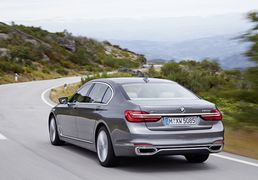PIONEERING a segment of the market means that you are the first out of the starting blocks, which gives your rivals a fair bit of time to analyse and benchmark their products based on what went before them.
The Lexus RX was one of the first compact premium SUVs to be launched in 1998 and remains the company’s most successful model to date, having accounted for 18% of its global sales last year. The US and China in particular have been a resounding success for the model, according to a company spokesman, with the US alone selling upward of 100,000 units each year.
While our market continues to be fertile ground for the German marques which continue to be a popular choice, Lexus seems intent on grabbing a small piece of the segment’s pie. The previous generation RX model was a polished and refined proposition with high levels of specification as standard.
However, it was marred by a slightly cramped rear and boot, which made the model more a rival to the BMW X3 than the larger X5.
To try to address that anomaly, the latest model, although fundamentally based on the previous generation, has a 55mm longer wheelbase, while overall length has been increased by 120mm. It is also 10mm wider, but overall height has been decreased by 20mm.
While styling remains a subjective matter, our first impression of the new model was rather underwhelming in the pictures, but it does seem to be a more pleasing exercise in the metal.
That signature spindle grille and sharper headlight units are similar to that of the NX with its origami-inspired design theme. The rear, meanwhile, is similar to the outgoing model with the tapering roofline, although the roof itself now has a floating design thanks to the blacked out C-pillars.
LED daytime running lights are standard, while the rear clusters on the hybrid now also incorporate sequential indicators that swish from one side of the lamp to the other, Audi style.
The cabin is not dissimilar to that of the NX and remains well laid out and highly specified with little in the way of optional extras. The 12.3-inch infotainment display incorporates most of the vehicle’s settings including the climate control and navigation system. Voice command and Bluetooth are also standard fare, as is the wireless charger for compatible smartphones.
The company also employed Yamaha to design the wood and aluminium veneer finish on the centre console, which is tastefully done and lifts the overall cabin ambience. Legroom has improved compared to the previous model, although headroom might plague taller individuals due to the tapering roofline. Boot space is still not the model’s forte measuring 453l with rear seats up in both variants, which falls short of rivals. Safety equipment includes cross-traffic detection and lane-keeping assist.
As in the outgoing model, two engine derivatives are available in the form of the 3.5l V6 with 221kW and 370Nm in the RX350, while the hybrid’s (RX450h) engine pushes out 193kW and 335Nm, augmented by two electric motors — 123kW on the front axle and 50kW at the rear — to give a total system output of 230kW.
Transmissions come in the form of an eight-speed automatic in the RX350 and a CVT (continuously variable transmission) in the RX450h.
Driving both models at the launch in the environs of Mpumalanga highlighted a more refined vehicle overall with good on-road manners and a fairly comfortable ride quality, in spite of the 20-inch standard tyres shod on both models.
We also managed to subject the vehicles to gravel roads, which were littered with ruts and dongas and it was here that the all-wheel-drive system proved its mettle, no matter how much we tried to unsettle the car.
The hybrid is claimed to be 9.5% more efficient than the outgoing model with a fuel consumption figure of 5.7l/100km. However, you can expect a more realistic figure of about 12l/100km, as I found during our launch drive. The regenerative braking system is still in place to recoup energy for the batteries and thankfully the brake pedal itself is now modulated to have a more conventional feel to it.
The RX350 is said to be 9% more efficient than its predecessor and it was easily my pick of the two models, offering sufficient grunt to hurl it up the coiling roads between White River and Hazyview. Here the vehicle felt nimbler than its hybrid counterpart, which weighs slightly more due to the hybrid system’s ancillaries.
While overseas markets also get a four-cylinder, entry-level model powered by the company’s 2.0l turbo engine from the NX, there are sadly no plans to bring that model to our shores according to Lexus SA, which is a pity. At a starting price of R799,000 for the RX350 and R999,000 for the 450h, an even cheaper model would be a most welcome addition to the range.
As it stands, some of the German counterparts still offer a more comprehensive range of engines, including some superb diesels. The latest RX is a marked improvement over the outgoing model, but with only two derivatives and comparably less boot and passenger space than some of its rivals, it does have its work cut out for it.
-

The Lexus RX has adopted the origami inspired styling that first debuted on the NX. . Picture: QUICKPIC
-

The infotainment screen shows all the essential info. Picture: QUICKPIC
-

In typical Lexus fashion, the interior is packed with features. Picture: QUICKPIC
-

The rear styling looks better in the metal than in pictures. Picture: QUICKPIC
PIONEERING a segment of the market means that you are the first out of the starting blocks, which gives your rivals a fair bit of time to analyse and benchmark their products based on what went before them.
The Lexus RX was one of the first compact premium SUVs to be launched in 1998 and remains the company’s most successful model to date, having accounted for 18% of its global sales last year. The US and China in particular have been a resounding success for the model, according to a company spokesman, with the US alone selling upward of 100,000 units each year.
While our market continues to be fertile ground for the German marques which continue to be a popular choice, Lexus seems intent on grabbing a small piece of the segment’s pie. The previous generation RX model was a polished and refined proposition with high levels of specification as standard.
However, it was marred by a slightly cramped rear and boot, which made the model more a rival to the BMW X3 than the larger X5.
To try to address that anomaly, the latest model, although fundamentally based on the previous generation, has a 55mm longer wheelbase, while overall length has been increased by 120mm. It is also 10mm wider, but overall height has been decreased by 20mm.
While styling remains a subjective matter, our first impression of the new model was rather underwhelming in the pictures, but it does seem to be a more pleasing exercise in the metal.
That signature spindle grille and sharper headlight units are similar to that of the NX with its origami-inspired design theme. The rear, meanwhile, is similar to the outgoing model with the tapering roofline, although the roof itself now has a floating design thanks to the blacked out C-pillars.
LED daytime running lights are standard, while the rear clusters on the hybrid now also incorporate sequential indicators that swish from one side of the lamp to the other, Audi style.
The cabin is not dissimilar to that of the NX and remains well laid out and highly specified with little in the way of optional extras. The 12.3-inch infotainment display incorporates most of the vehicle’s settings including the climate control and navigation system. Voice command and Bluetooth are also standard fare, as is the wireless charger for compatible smartphones.
The company also employed Yamaha to design the wood and aluminium veneer finish on the centre console, which is tastefully done and lifts the overall cabin ambience. Legroom has improved compared to the previous model, although headroom might plague taller individuals due to the tapering roofline. Boot space is still not the model’s forte measuring 453l with rear seats up in both variants, which falls short of rivals. Safety equipment includes cross-traffic detection and lane-keeping assist.
As in the outgoing model, two engine derivatives are available in the form of the 3.5l V6 with 221kW and 370Nm in the RX350, while the hybrid’s (RX450h) engine pushes out 193kW and 335Nm, augmented by two electric motors — 123kW on the front axle and 50kW at the rear — to give a total system output of 230kW.
Transmissions come in the form of an eight-speed automatic in the RX350 and a CVT (continuously variable transmission) in the RX450h.
Driving both models at the launch in the environs of Mpumalanga highlighted a more refined vehicle overall with good on-road manners and a fairly comfortable ride quality, in spite of the 20-inch standard tyres shod on both models.
We also managed to subject the vehicles to gravel roads, which were littered with ruts and dongas and it was here that the all-wheel-drive system proved its mettle, no matter how much we tried to unsettle the car.
The hybrid is claimed to be 9.5% more efficient than the outgoing model with a fuel consumption figure of 5.7l/100km. However, you can expect a more realistic figure of about 12l/100km, as I found during our launch drive. The regenerative braking system is still in place to recoup energy for the batteries and thankfully the brake pedal itself is now modulated to have a more conventional feel to it.
The RX350 is said to be 9% more efficient than its predecessor and it was easily my pick of the two models, offering sufficient grunt to hurl it up the coiling roads between White River and Hazyview. Here the vehicle felt nimbler than its hybrid counterpart, which weighs slightly more due to the hybrid system’s ancillaries.
While overseas markets also get a four-cylinder, entry-level model powered by the company’s 2.0l turbo engine from the NX, there are sadly no plans to bring that model to our shores according to Lexus SA, which is a pity. At a starting price of R799,000 for the RX350 and R999,000 for the 450h, an even cheaper model would be a most welcome addition to the range.
As it stands, some of the German counterparts still offer a more comprehensive range of engines, including some superb diesels. The latest RX is a marked improvement over the outgoing model, but with only two derivatives and comparably less boot and passenger space than some of its rivals, it does have its work cut out for it.




























Change: 2.60%
Change: 2.92%
Change: 4.80%
Change: 2.21%
Change: 2.84%
Data supplied by Profile Data
Change: 2.22%
Change: 2.00%
Change: 2.60%
Change: 0.00%
Change: 1.95%
Data supplied by Profile Data
Change: -0.42%
Change: -0.67%
Change: -1.28%
Change: -1.22%
Change: -0.23%
Data supplied by Profile Data
Change: -2.86%
Change: -2.10%
Change: -3.30%
Change: -1.35%
Change: 1.11%
Data supplied by Profile Data